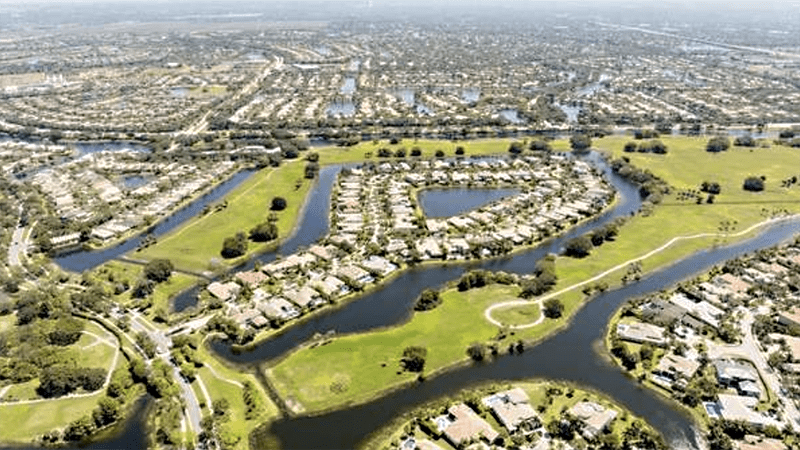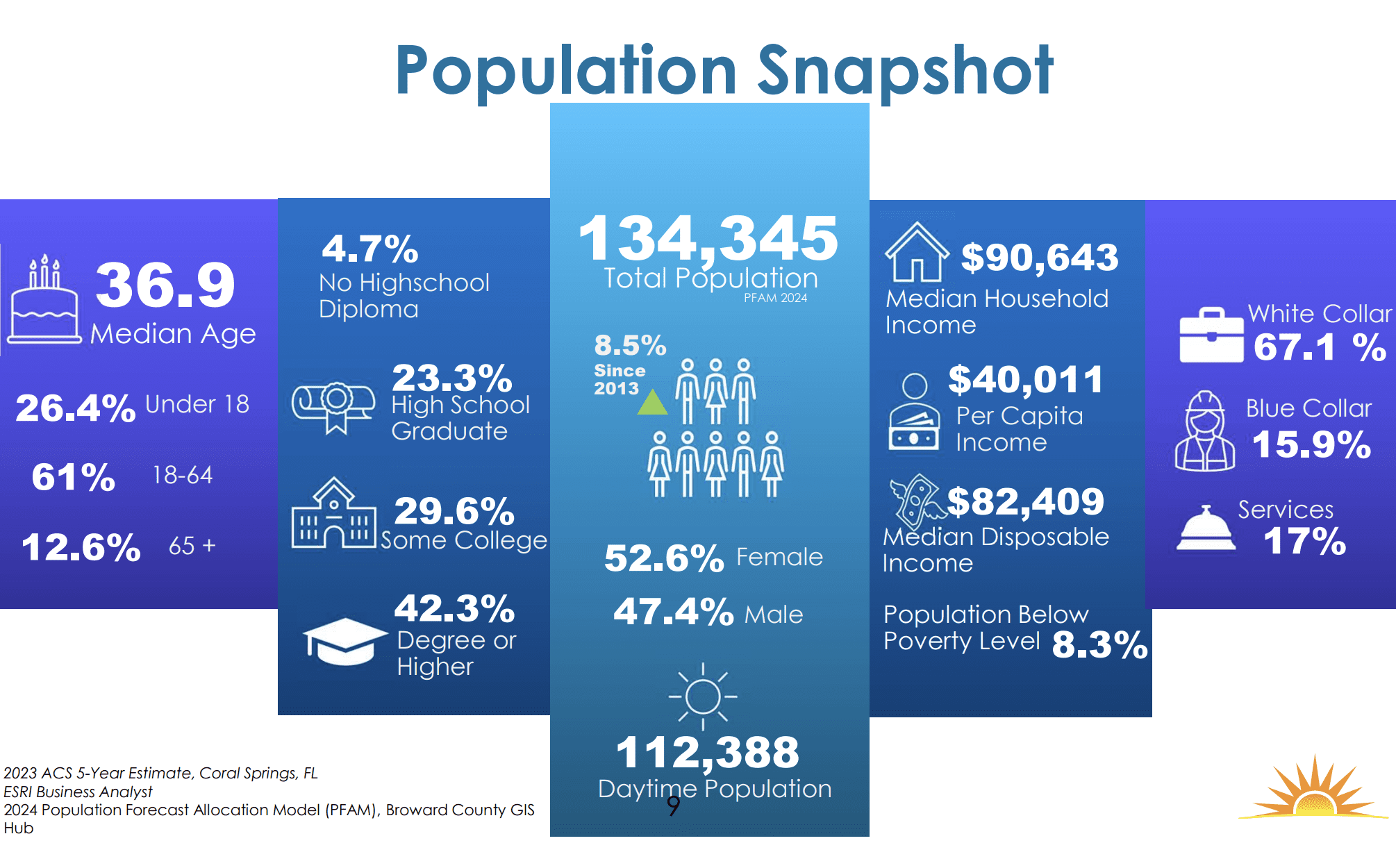
{City of Coral Springs}
On a late summer morning, the streets of Coral Springs hum with the quiet rhythm of suburban life. Joggers trace tree-lined paths, school buses rumble through neighborhoods of attractive homes, and families push strollers past tree-shaded playgrounds.
From the outside, the city looks much as it has for decades: orderly, family-friendly, and comfortably suburban.
But just beneath that familiar image, Coral Springs is changing. Data from a new planning document created by city officials tells the story of a community at a crossroads — no longer a fast-growing suburb, but a built-out city grappling with rising diversity, rising incomes, and the steep climb of housing costs that threaten to reshape who can afford to call it home.
Coral Springs was born in the 1960s as a planned community on former farmland. Developers laid out canals and cul-de-sacs in careful grids, advertising a suburban lifestyle that promised space, safety, and affordability. Families came in droves. By the early 2000s, the city had grown into one of Broward County’s largest, its population more than doubling since 1980.
Today, that era of breakneck expansion is over. The city is bordered by the Everglades to the west and hemmed in by development on every other side. With little land left to build on, Coral Springs is effectively full.
The result is slower growth: between 2013 and 2024, the city’s population grew by 8.5 percent, bringing its population to 134,345. Just a fraction of that growth happened in recent years.
“We are built out,” Coral Springs Director of Development Services Tina Jou states in a new affordable housing document.
Yet if the numbers suggest stasis, the reality is more complicated. Even without swelling in size, Coral Springs is being reshaped in ways that go beyond its borders.
Perhaps the most striking change has been demographic.
At the turn of the millennium, around seven in ten Coral Springs residents were non-Hispanic White. Today, that share has dropped to about 35 percent, according to U.S. Census data. Hispanic residents now account for around 30 percent of the city’s population, Black residents for around 24 percent, and Asian residents for about 5 percent, data shows. The rest of the population falls into other categories.
This evolution has transformed Coral Springs into a true mosaic of cultures. Walk through its schools or its parks and the diversity is visible and audible — in languages spoken, in foods shared, in festivals celebrated. The city still feels suburban, but its cultural identity is layered, reflecting the broader story of South Florida’s transformation.
Economically, Coral Springs is thriving on paper. The median household income in 2023 was $90,643, up nearly four percent from the year before. Unemployment is low, and the city’s poverty rate sits at about 8 percent.
The employment base is steady and varied, anchored in retail trade, health care, and professional services. Families that moved here for stability have, in many cases, seen their incomes grow. Coral Springs remains a middle-class and professional enclave — the kind of place where households can imagine upward mobility.
But prosperity has not translated evenly. Even as incomes rise, housing costs are rising faster.
The median home sale price was around $680,000 in the second quarter of 2025, versus $627,500 for Broward County as a whole, records show. For homeowners, monthly payments are steep: 30 percent of them are cost-burdened, spending 30 percent of their income or more on housing, while renters spend $2,417 in rent on average for a two-bedroom apartment.

{City of Coral Springs}
Federal data shows that 62 percent of renters in the city are cost-burdened.
The pressures are compounded by the age of the city’s housing stock. Most homes were built before 2000, during Coral Springs’ rapid expansion. Only a fraction of homes in the city have been built since then, records show.
That means buyers often contend with aging properties that require costly upkeep, while the lack of new development fuels competition for limited housing supply. Rising property insurance costs are only adding to the burden for families.
City leaders are well aware of the challenge. Coral Springs officials have identified affordable housing as one of the city’s highest priorities. Federal block grants are being steered toward rehabilitating older homes and funding services for low-and moderate-income residents.
Officials say they are encouraging affordable housing and more market-rate rental units “where appropriate,” according to city documents.
A 2022 Broward County Needs Assessment showed the county had an affordable housing gap of 147,042 units.
But with the city largely built out, any local solution is unlikely to come from sprawling new neighborhoods. Analysts project steady demand for apartments and townhomes, particularly among younger families and working professionals priced out of the single-family home market.
That shift would mark a new chapter for a city once defined by its subdivisions.
Coral Springs remains in many ways what it has always aspired to be: a safe, family-oriented city with strong schools, diverse neighborhoods, and a sense of stability. But the forces now shaping it — demographic change, rising incomes, and the unrelenting climb of housing costs — point to a more complicated future.
City commissioners and department heads will discuss the city’s housing challenges and other issues at the commission’s annual retreat at 4 p.m. Wednesday at the Public Safety and Public Works Complex, 4150 Northwest 120th Ave.
Send Your News to Coral Springs’s #1 Award-Winning News Site Here. Don’t Miss Parkland Talk, Tamarac Talk, Coconut Creek Talk, and Margate Talk.
Author Profile

Related
 Crime & SafetyDecember 18, 2025Federal Jury Convicts Coral Springs Woman in Multi-Million-Dollar Nursing Diploma Scheme
Crime & SafetyDecember 18, 2025Federal Jury Convicts Coral Springs Woman in Multi-Million-Dollar Nursing Diploma Scheme Crime & SafetyDecember 16, 2025$5K Reward Offered in Coral Springs Truck Theft Case
Crime & SafetyDecember 16, 2025$5K Reward Offered in Coral Springs Truck Theft Case Crime & SafetyDecember 16, 2025Coral Springs Commission to Vote on $1.3M Purchase of New Fire Rescue Vehicles
Crime & SafetyDecember 16, 2025Coral Springs Commission to Vote on $1.3M Purchase of New Fire Rescue Vehicles NewsDecember 14, 2025‘A Mom on a Mission’: Jennifer Levi Launches Bid for Coral Springs Commission Seat 4
NewsDecember 14, 2025‘A Mom on a Mission’: Jennifer Levi Launches Bid for Coral Springs Commission Seat 4








